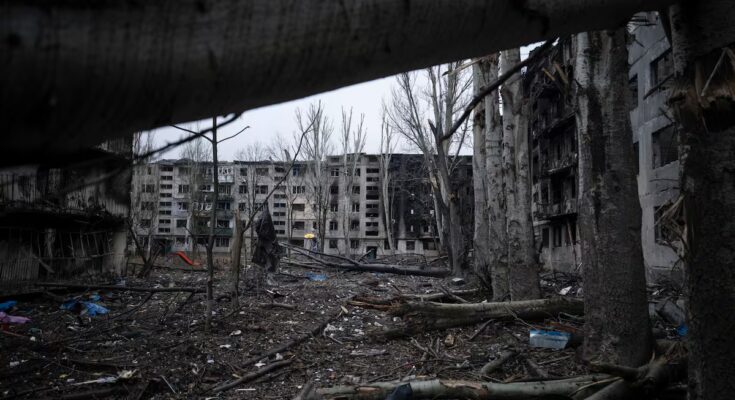A Russian soldier, his face blurred, poses in front of the bodies of three Ukrainian soldiers who lie face down in a pool of blood, their hands clasped behind their heads. The image, shared by the Russian Rusich unit on his Telegram channel, is accompanied by the announcement of a contest: “The first three people to send a photo of prisoners who have clearly been erased from existence will receive a cryptocurrency reward.” This is a war crime, yet another crime in the relentless conflict that the Kremlin describes as a “special military operation.” This time, however, a competition broke out in which the Ukrainian forces also joined.
The photo was initially released last week by other Russian ultranationalist channels. Then, a fighter from the Russian Volunteer Corps, a unit that supports Ukraine and fights against the Kremlin, saw it and shared it on his Instagram profile, calling for revenge. The Sabotage Assault Reconnaissance Group (Rusich), saw the position and turned the situation into a bloody contest, with prizes.
“Learn a lesson from the enemy: This is what a victorious army looks like, not a gang,” said the pro-Ukrainian military officer, nicknamed Slavian, urging his men to imitate their enemies.
In his next post, the member of the Russian Volunteer Corps shared images sent to him by other Ukrainian soldiers, showing them posing with the bodies of dead Russian fighters. In one video, a soldier shot a deceased Russian man in the head in the middle of a forest, alongside the caption: “Long live death.” According to the Russian Volunteer Corps, speaking to independent news channel Sota, their official position is “not to touch prisoners” and Slavian’s challenge is only to “take photos with dead soldiers.” This claim has not been verified.
Slavian’s words were paraphrased by Rusich days later. “Take note. This is how you photograph a victorious army, not a defeated one,” the unit countered last weekend, announcing its competition.
This is not the first time Rusich has proposed executing prisoners of war. At the start of the invasion in 2022, when the first exchanges of captured troops between Moscow and Kiev were made public, the unit published a guide titled “Instructions for the elimination of prisoners of war of the Armed Forces of Ukraine.”
The document recommended not informing soldiers of other Russian companies about the executions. “If it has been reported, report that the enemy is wounded and may die,” he advised.
However, the executions are not great. Ukraine reported a wave of prisoner of war killings in 2024. And a year ago, Russian President Vladimir Putin posed with the flag of the 155th Marine Infantry Brigade during his traditional annual address to the media and public. That unit, in fact, had been accused of impaling the severed heads of Ukrainian soldiers.
According to Russian veterans who spoke to this newspaper, snipers and drone pilots are often the most vulnerable to death when they surrender. Their executions, shown in videos, range from point-blank shootings to beheadings. “The front is terrible. The shock makes it impossible for some to behave humanely. A person who experiences this cannot be normal after the war, in any country,” a Russian commander said months ago.
The Geneva Convention relating to the Treatment of Prisoners of War, to which both Russia and Ukraine are signatories, expressly prohibits the execution of surrendered soldiers.
Among the prohibited acts provided for in Article 3 of the Convention, a pillar of international law, are: “Violence against life and person, in particular murder of all kinds, mutilation, cruel treatment and torture” and “the passing of sentences and the carrying out of executions without prior judgment pronounced by a duly constituted court offering all the judicial guarantees recognized as indispensable by civilized persons”.
In any case, it is Moscow and Kiev, not Rusich or any other specific unit of either side, that are ultimately responsible for these war crimes. “Prisoners of war are in the hands of the enemy Power, but not of the persons or military units who captured them. Regardless of any individual responsibilities that may exist, the Detaining Power is responsible for their treatment,” underlines Article 12 of the Geneva Convention.
Furthermore, the document provides that if the belligerent power cannot guarantee the protection of prisoners of war, it must entrust their safety to a neutral state or to organizations such as the Red Cross.
“Glory to Rus! Glory to Morana!” This was the slogan with which Rusich concluded the announcement of his running competition. The word “Rus” refers to several ancient Eastern European peoples of uncertain origins who gave rise to Kievan Rus, the first of several medieval Slavic states. Morana, for her part, was the ancient Slavic goddess of death.
Rusich, now part of the Russian Armed Forces, was a unit of the Wagner mercenary company. The group is known for its openly far-right ideology. Its leader, Alexey Milchakov, declared himself a Nazi in a 2014 interview with digital media Sputnik and Pogromand its symbol is the Kolovrat, an eight-pointed rune similar to a swastika popularized by Alexey Dobrovolsky, one of the fathers of Slavic neopaganism in Russia. The military patch is complemented by the white, yellow and black colors of the Imperial Russian flag.
The Russian Volunteer Corps (RDK) was founded by exiles with the aim of overthrowing the Kremlin. Its leader is Denis Kapustin, also known as Denis Nikitin, a martial arts fighter who has been linked to far-right groups in Europe and who has been banned from entering the Schengen area by Germany.
Sign up to our weekly newsletter to get more English-language news coverage from EL PAÍS USA Edition



